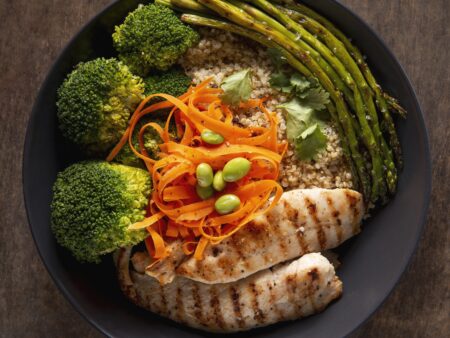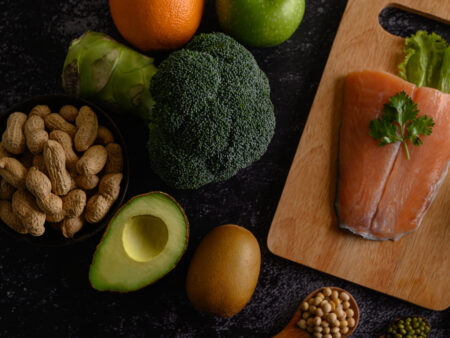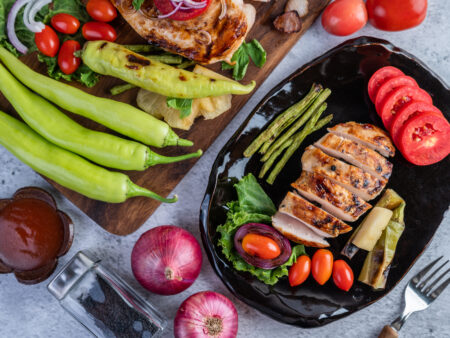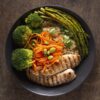
Achieving the dual goals of losing fat and gaining muscle can be challenging, yet highly rewarding. This comprehensive guide provides an in-depth look at the diet and lifestyle changes necessary to accomplish these objectives. We’ll discuss the benefits, disadvantages, and realistic timeframes for achieving these goals.
In addition, we’ll delve into effective workout routines tailored for maximizing fat loss while promoting muscle growth. Understanding the science behind metabolism and muscle building will empower you to make informed decisions on your fitness journey. Whether you’re a beginner or seasoned enthusiast, this guide offers practical strategies to optimize your body composition and overall health.
Benefits of Losing Fat and Gaining Muscle
1. Improved Physical Health:
Reduced Risk of Chronic Diseases: Lower body fat reduces the risk of heart disease, diabetes, and certain cancers.
Enhanced Metabolic Rate: Muscle tissue burns more calories at rest compared to fat tissue, boosting your overall metabolism.
Better Joint Health: Reduced fat means less pressure on your joints, which can help prevent conditions like osteoarthritis.
2. Enhanced Physical Appearance:
Toned Physique: Building muscle while losing fat results in a more sculpted and toned body.
Increased Confidence: Improved physical appearance often boosts self-esteem and confidence.
3. Improved Physical Performance:
Strength and Endurance: Increased muscle mass enhances your strength and physical endurance.
Functional Fitness: Better muscle strength improves everyday functional movements and activities.
Disadvantages of Losing Fat and Gaining Muscle
1. Time and Commitment:
Consistency Required: Achieving significant changes in body composition requires a consistent effort over a prolonged period.
Lifestyle Adjustments: This journey often necessitates significant changes in diet, exercise, and overall lifestyle.
2. Potential for Initial Weight Gain:
Muscle Weighs More Than Fat: As you build muscle, you might notice an initial increase in weight even as you lose fat, which can be discouraging.
3. Nutritional Challenges:
Complex Dietary Needs: Balancing the need to consume enough protein for muscle growth while maintaining a caloric deficit for fat loss can be tricky.
Potential for Nutrient Deficiencies: Restrictive diets might lead to deficiencies in essential vitamins and minerals if not carefully managed.
Key Principles of Diet for Fat Loss and Muscle Gain
1. Caloric Balance:
Caloric Deficit for Fat Loss: To lose fat, you need to consume fewer calories than you burn. A moderate deficit of 500 calories per day is generally recommended.
Caloric Surplus for Muscle Gain: Building muscle requires a caloric surplus. This surplus should be moderate to avoid excessive fat gain.
2. Macronutrient Distribution:
High Protein Intake: Protein is crucial for muscle repair and growth. Aim for 1.6 to 2.2 grams of protein per kilogram of body weight.
Moderate Carbohydrates: Carbs provide the necessary energy for intense workouts. Focus on complex carbs like whole grains, fruits, and vegetables.
Healthy Fats: Healthy fats are important for hormone production and overall health. Include sources like avocados, nuts, seeds, and olive oil.
3. Meal Timing:
Pre-Workout Nutrition: Consuming a balanced meal with protein and carbs before workouts provides energy and aids muscle preservation.
Post-Workout Nutrition: A post-workout meal rich in protein and carbs helps with muscle recovery and replenishes glycogen stores.
Sample Diet Plan
Breakfast:
Option 1: Scrambled eggs with spinach, whole grain toast, and a side of berries.
Option 2: Greek yogurt with mixed nuts, seeds, and honey.
Mid-Morning Snack:
Option 1: Apple slices with almond butter.
Option 2: Protein shake with a banana.
Lunch:
Option 1: Grilled chicken breast, quinoa, and steamed broccoli.
Option 2: Lentil salad with mixed greens, cherry tomatoes, cucumbers, and olive oil dressing.
Afternoon Snack:
Option 1: Cottage cheese with pineapple chunks.
Option 2: Handful of mixed nuts and a piece of dark chocolate.
Dinner:
Option 1: Baked salmon, sweet potato, and asparagus.
Option 2: Stir-fry with tofu, bell peppers, broccoli, and brown rice.
Evening Snack:
Option 1: Casein protein shake or cottage cheese.
Option 2: Sliced turkey breast with avocado.
Exercise and Lifestyle Tips
- Strength Training:
Frequency: Aim for at least 3-4 days of strength training per week to allow for adequate muscle stimulation and recovery.
Focus on Compound Movements: Exercises like squats, deadlifts, bench presses, and rows engage multiple muscle groups and are highly effective for muscle gain and functional strength.
Progressive Overload: Gradually increase the weight or resistance to continually challenge your muscles and stimulate growth, ensuring continued progress over time.
- Cardiovascular Exercise:
Frequency: Include cardio 2-3 times per week to improve cardiovascular health and enhance fat-burning potential.
HIIT vs. Steady-State: High-Intensity Interval Training (HIIT) is effective for fat loss due to its metabolic impact, while steady-state cardio supports cardiovascular health and endurance.
- Rest and Recovery:
Importance of Sleep: Aim for 7-9 hours of quality sleep per night to support muscle recovery, hormone regulation, and overall physical and mental well-being.
Active Recovery: Incorporate light activities like walking or yoga on rest days to promote blood flow, reduce muscle stiffness, and enhance overall recovery, ensuring you’re primed for your next workout.
Realistic Time Frame
1. Short-Term Goals:
Initial Changes: Noticeable changes in body composition can typically be seen within 4-8 weeks with consistent effort.
2. Long-Term Goals:
Sustainable Results: Significant and sustainable changes in muscle mass and fat loss often require 6-12 months of dedicated effort.
The Science Behind It
- Understanding the science behind metabolism and muscle building is crucial for anyone striving to optimize their fitness journey. Metabolism, the intricate process by which the body converts food into energy, plays a pivotal role in both fat loss and muscle gain. By comprehending factors such as basal metabolic rate (BMR), thermic effect of food (TEF), and non-exercise activity thermogenesis (NEAT), individuals can tailor their nutrition and exercise routines to support their specific goals.
- Additionally, grasping the mechanisms of muscle hypertrophy, including protein synthesis, muscle damage, and metabolic stress, empowers individuals to design effective strength training programs that stimulate muscle growth efficiently. Armed with this knowledge, individuals can make informed decisions about their diet, exercise regimen, and overall lifestyle, ultimately maximizing their results and achieving their desired physique.
Losing fat while gaining muscle is a challenging yet attainable goal that requires a well-planned diet, consistent exercise regimen, and lifestyle adjustments. The benefits of improved physical health, enhanced appearance, and increased performance far outweigh the disadvantages, making the journey worthwhile. By understanding the principles of caloric balance, macronutrient distribution, and the importance of meal timing, you can create a sustainable diet plan that supports your goals. Remember, patience and consistency are key, and with time, you’ll achieve the body composition and health benefits you’re striving for.






